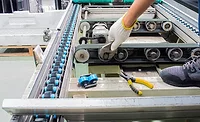Logistics
The DTC logistics evolution
Direct-to-consumer sales are growing due to brands craving a closer connection to their customers, as well as having more control over the product journey.
.webp?t=1646337826)
Photo credit: Adobe Stock
While traditional business models are still turned upside down due to the ongoing global pandemic, small and large food brands alike are capitalizing on the ascendant e-commerce trend of direct-to-consumer (DTC) shipping, while restaurants have followed suit with increased home delivery.
Trends show that this is working for U.S. consumers. In addition to the pandemic-fueled 45.5% growth from 2019 to 2020, U.S. digital D2C sales were expected to grow another 15.9% in 2021, reaching $175 billion by 2023, according to an eMarketer report.
DTC product sales happen exactly as stated: a brand ships directly to the end consumer without an intermediary such as third-party retailers or wholesalers. The business connects and transacts with its customers directly through mostly online platforms.
While traditional functions of logistics include various steps—order processing, material handling, warehousing, inventory control, transportation and packaging—companies that offer DTC perform many of these functions internally.
While many larger brands still use third-party logistics providers, companies like Wildgrain—a subscription-based bakery brand—have opted for the DTC route. The Boston-based company ships artisan breads, pasta and pastries directly to consumers with free shipping.
We asked Brendan Duttry, director of operations at Wildgrain, to walk us through each step of their DTC logistics process—from the making their products to consumer delivery—for an example of how a food processor engages in the DTC process.
In addition, we also asked logistics company Smart Warehousing—a 3PL provider with 38 warehouses totaling 12 million sq. ft. across the U.S.—to offer a few observations regarding DTC for processors, and what trends might be on the horizon for this still growing e-commerce strategy.

Fresh-Baked to Front Door
Product production
Wildgrain works as a subscription model. Consumers choose a membership and a box frozen baked goods are delivered each month. Each box comes with products to complement 30+ individual meals, including sourdough breads, fresh pastas and artisanal pastries, which remain frozen through delivery.
Customer communication
One benefit of DTC for processors is more control over how products are packed, and how customers unbox them. This also allows brands like Wildgrain to hear direct feedback from customers about the DTC process and product condition upon arrival.
“We invest heavily in customer engagement and wherever possible, we make improvements to our product as quickly as possible,” Duttry says. The company is also in constant communication with their fulfillment partners. “If there is an issue with a customer’s order, Wildgrain tracks it in a way that allows us to quickly present performance data to each fulfillment partner, and work with them to realize improvement as quickly as possible,” he adds.
Smart Warehousing’s Founder and CEO, Carl Wasinger, adds that although his company handles logistics and fulfillment for various clients, Smart Warehousing stays in the background so companies have more room to connect with their audience.
Packaging
Wildgrain assembles cardboard boxes using a special adhesive “such that our boxes have better water resistance performance compared to most off-the-shelf cardboard boxes,” Duttry explains. It makes the box stronger and more resistant to humidity and precipitation during transit—particularly important for frozen foods. An eco-friendly insulation liner is then added to the box, which minimizes the rate at which heat can enter.
In addition to the insulation, dry ice is added to the box. Prior to packing the dry ice, gel packs are also placed in each box. “The gel packs have a much greater density than Wildgrain products, and thus will continue to maintain a low temperature for long after the dry ice has completely sublimated,” he further explains.
Fulfillment
For some F&B companies, the downsides of a DTC platform include rising shipping costs and having to navigate complex logistics. This is where a fulfillment provider can help if the task is too much for the processor to handle.
“We manage inventory across channels for customers and call it SWIMS: Smart Warehousing Information Management System,” said Wasinger. SWIMS provides a system of record for inventory, giving control and visibility to their clients. The cloud-based service allows for real-time inventory insights, transaction-level updates and a summary of all activity. The company works with brands to serve Omni channel, e-commerce, DTC and retail.
Wildgrain uses several fulfillment centers throughout the U.S., which were selected based on their geographic location (allowing the most efficient shipping to customers) as well as their ability to adapt to changes in their business as they grow.
“Currently we use multiple logistics providers for warehousing our inventory as well as packing and shipping customer orders,” Duttry says. “In our early days, we actually did it all ourselves, from baking, to packaging each bread loaf, pasta package and pastry, to packing the customer’s box and handing the box to UPS.”
Warehousing
A logistics company may not offer fulfillment and warehousing as combined services, so make sure to ask when researching providers whether they offer both if your company needs it.
DTC shipping requires picking and packing of smaller units from a large inventory inside of a warehouse or sometimes multiple warehouses. “This requires maintaining close attention to ensure that orders are fulfilled correctly, and that inventory is managed properly inside of each warehouse,” explains Duttry.
Wasinger adds that other warehouse needs for DTC include areas that have both ambient and cold storage space for refrigerated and frozen foods, and the ability to store and handle small and sometimes seasonal quantities of product.

Transportation
The next step in the DTC platform is transportation. How does the product get to the consumer’s home, and how has it changed since the pandemic?
“The change in transportation time depends on the product being transported. Transportation time itself has not impacted us noticeably,” says Duttry. “We can still move product around the United States on schedule. However, there are certainly challenges with this.”
Some of those challenges include a shortage of trucks and drivers, and increasing costs. Still, Wildgrain offers free shipping so the wait for the consumer may not hit as hard. Lead time on boxes and packaging products has increased due to a strained supply chain of bulk materials. However, Wildgrain has been successful in managing around this. Many businesses have been required to make sacrifices in storage space and cost in order to stop supply chain issues from affecting their customers.
Smart Warehousing helps manage transport for some clients, but they have other customers who prefer to handle their own shipping. However, “most would rather outsource the shipping because of the ease of it,” Wasinger says.
“The internet is a great equalizer for retail and DTC,” --Carl Wasinger, founder/CEO, Smart Warehousing
What’s ahead?
eMarketer senior forecasting analyst Oscar Orozco said that “even though consumers are buying more products online due to the coronavirus, sales will continue to shift from nice-to-have products to must-have products, with D2C brands falling under the nonessential category. Disruptions in the supply chain are also likely. That will mean slower shipping times, normally a distinguishing factor for D2C products,” he added.
Duttry advises other processors to “never stop researching your options with logistics, whether they be services, technology, or products. Taking a ‘set in your ways’ approach may seem comfortable, but certainly won’t be sustainable. Strong relationships with our logistics partners as well as prioritization of high-quality service have allowed us to do what’s most important: make our customers happy,” Duttry adds.
Ready for DTC?
Brendan Duttry, director of operations at Wildgrain, a subscription-model DTC brand, and Carl Wasinger, founder/CEO of logistics provider Smart Warehousing, offer tips for those interested in a DTC channel.
 Duttry:
Duttry:
- Be ready to adapt to fast changes in demand as well as track performance and issues in the most efficient way possible for an effective DTC program. “Figuring it out later” and “backfilling information” can cause too much lost time (and potentially business) when dealing with an issue.
- Have standard operating procedures ready at all times. You need a concise, documented program to produce and ship the finished products you want to see. Also, ensure that everyone (staff and fulfillment partners) is familiar with those procedures.
- Spend time working at all levels of a food processing operation. Challenges are more solvable when you have a good understanding of what’s happening on your production floor before shipping. Then, develop relationships with the people that will be handling your products for DTC shipping.
Wasinger:
- Today’s consumers don’t like to plan or wait, and nobody pays a premium anymore for a product. Keep this in mind if you decide to go the DTC route.
- After you decide to add DTC, think about your network—who is going to help consistently update and support it?
- There are three ways to start DTC: Build your own platform and systems; move into other platforms like Amazon, Walmart, etc. (but give away some profit doing it); or plug into a provider who supports logistics, network, the technology, so you keep more of your profit.
Avoiding pitfalls
To avoid the most common DTC pitfalls, Duttry advises to conduct careful research ahead of time to ensure that any new partner, facility or other investment in a DTC program is going to work for your operation. “Do not jump to the first opportunity and do not fail to ensure that future changes can be made as you grow and learn.”
Another point? Be sure to stay in constant contact with your vendors, he adds. Surprises can happen and lead times for supplies can change very quickly.
And, don’t forget a “top down” view of your operations. Duttry suggests that, when possible, delegate issues and responsibilities. It’s easy to lose sight of other aspects of the business while focusing on DTC tasks.
“I once began a program during the busiest time of year for shipping. This yielded many unfortunate surprises. Work with your partners to ensure that any new project is started when you can devote the most attention to properly launch and efficiently refine the project,” Duttry suggests.
Looking for a reprint of this article?
From high-res PDFs to custom plaques, order your copy today!






